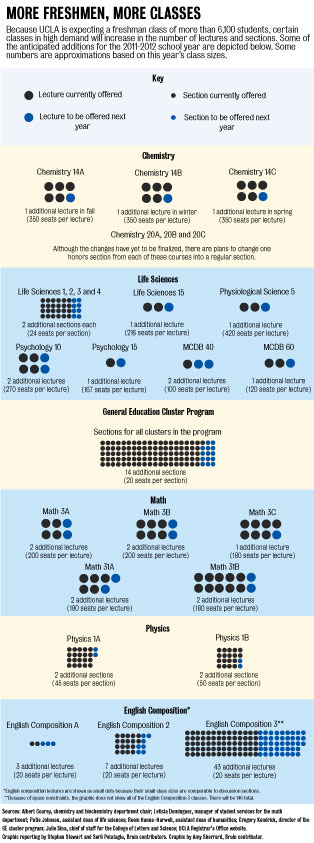The prospect of the largest freshman class in UCLA’s history has sent administrators and faculty scrambling to expand classes to meet future demands.
UCLA exceeded its enrollment target by roughly double what administrators were expecting. As a result, the College of Letters and Science needed to secure enough general education classes before freshman orientation, said Julie Sina, chief of staff for the College of Letters and Science.
To accommodate the increase in undergraduates, departments will hire additional lecturers and teaching assistants. The chancellor’s office has announced that an additional $15.6 million will be provided to help fund these changes.
“(Hiring) is being done in more of a hurry than we would like, because it’s so late in the year,” said Bruce Beiderwell, director of Writing Programs.
Beiderwell said he anticipates adding four lectures to the English composition courses and two lectures for English as a Second Language.
This is possible through an expected 25 percent increase in funding for the ESL department and English composition courses, said Reem Hanna-Harwell, the assistant dean of humanities.
While the life sciences plan to similarly increase class sizes and the number of lectures offered, some department heads are still left in a tight position.
For instance, the chemistry and biochemistry department is prepared to expand its core prerequisite courses by opening honors sections and adding lectures. But, the department is unsure of how to fit more students in lab classes.
“We really are impacted because we don’t have the lab space to open up more slots,” said department chair Albert Courey. “The summer lab classes are already filled up. It’s a real problem, and there is no easy solution.”
One remedy would be to reduce the number of required lower division labs, Courey said. For example, biochemistry students are now only required to take one lower division lab class instead of two, he said.
Meanwhile, the math department will add 10 lower division lectures to the Calculus III series and 31 series.
Leticia Dominguez, manager of student services, said she was notified Friday that the math department should hire extra teachers.
A number of teaching assistants will be hired to supplement the department’s increase, said James Ralston, chair of the math department.
General education clusters, which began a decade ago, will increase to accommodate 280 additional students. This year, 52 percent of freshmen are enrolled in the cluster program, said Gregory Kendrick, the director of the cluster program.
Keith Stolzenbach, a professor for the Global Environment cluster, has taught the cluster since its inception in 1997. Next year his class will grow from 160 to 200 students.
“I think its okay,” Stolzenbach said, “I think there’s a limit as long as we can do it without negatively affecting instruction. I probably wouldn’t want to grow much more.”
For now, Sina said, these expansions are subject to change, depending on funding and student demand.
